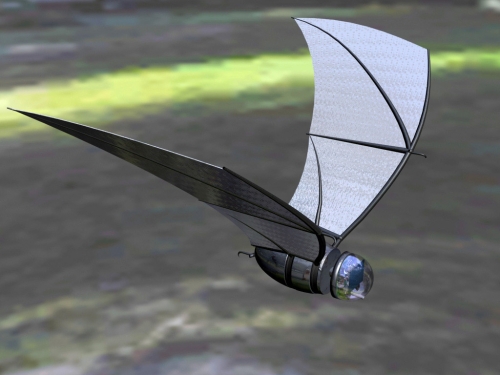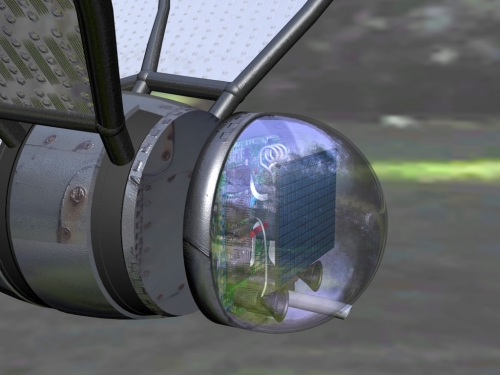Eco-friendly structures don't have to look like ugly gray boxes. In fact, saving the enviromment can inspire some of the best design out there. Here are five ways biomimetics takes the elegance of nature, and makes it work for us.
1. Termite mounds as buildings

Termite mounds are gigantic heaps of mud, out in the sun all day in the desert. We have a word for what they should be like: ovens. Instead, they're cooled by a complicated system of passageways and materials designed to funnel hot air out, and let cool air in.
Already, there are buildings based on this concept. During the day, they store hot air in certain areas and save it up in materials that absorb a lot of heat. At night, vents open at the top of the building and the hot air shoots out. This creates a minor vacuum that sucks in cool, dense, night air from vents at the bottom of the building.
As you can see, these buildings look good on the inside. On the outside, so far, they look like regular buildings. Some day, with luck, the designers will get over their human hang-ups and design them to look like termite mounds. That will be a fun day.
2. Windmills of whale flukes.
You know what's huge and heavy, but gets around the ocean efficiently? A whale.
The folks at Whale Power noticed this, as well as the bumps on the front of whale's flukes. The tubercles reduce drag, allowing the whale to move more efficiently through the ocean. Whale Power wants to use that to make fans use less energy, and help windmills provide more energy. By cutting out the waste, they can make everything more efficient and beautiful, from wind turbines to the little fan cooling your computer.
3. Giant metal seaweed and fishtails that harvest energy
A new way to solve the energy crisis will liven up the scuba-diving experience. Metal structures placed on the sea floor will use the motion of the waves to harvest energy from the ocean. As they get pushed back and forward, they will drive generators. This particular model uses the shape and bouyancy of seaweed. As an added bonus, it will, like kelp, lie flat against the ocean floor when the seas get too rough, minimizing damage.
Another design by the same company, BioPower, doesn't have the advantage of laying low.
It will, however, gain extra energy from the motion of any shark that chooses to attack it.
4. Batplane
ANN ARBOR, Mich.—A six-inch robotic spy plane modeled after a bat would gather data from sights, sounds and smells in urban combat zones and transmit information back to a soldier in real time. That's the Army's concept, and it has awarded the University of Michigan College of Engineering a five-year, $10-million grant to help make it happen. The grant establishes the U-M Center for Objective Microelectronics and Biomimetic Advanced Technology, called COM-BAT for short. The grant includes an option to renew for an additional five years and $12.5 million. U-M researchers will focus on the microelectronics. They will develop sensors, communication tools and batteries for this micro-aerial vehicle that's been dubbed "the bat." Engineers envision tiny cameras for stereo vision, an array of mini microphones that could home in on sounds from different directions, and small detectors for nuclear radiation and poisonous gases. Low-power miniaturized radar and a very sensitive navigation system would help the bat find its way at night. Energy scavenging from solar, wind, vibration and other sources would recharge the bat's lithium battery. The aircraft would use radio to send signals back to troops. COM-BAT also involves the University of California at Berkeley and the University of New Mexico. It is one of four centers the Army launched as a collaborative effort among industry, academia and the Army Research Laboratory to work toward this vision of a small, robotic aircraft that could sense and communicate. Each of the four centers is charged with developing a different subsystem of the bat, a self-directed sensor inspired by the real thing. "Bats have a highly-attuned echolocation sense providing high-resolution navigation and sensing ability even in the dark, just as our sensor must be able to do," Sarabandi said. The bat robot's body would be about six inches long. It would weigh about a quarter of a pound and use about 1 W of power. U-M researchers intend to improve on current technologies. They'll work to develop quantum dot solar cells that double the efficiency of current cells. They expect their autonomous navigation system, which would allow the robot to direct its own movements, to be 1,000 times smaller and more energy efficient than systems being used now. They believe they can deliver a communication system that's 10 times smaller, lighter and more energy efficient than today's technologies. The bat would be designed to perform short-term surveillance in support of advancing soldiers. Or it could perch at a street corner or building for longer assignments and send back reports of activity as it takes place. COM-BAT will support 12 faculty members and 18 graduate students at U-M.
Engineers envision a six-inch, robotic spy plane modeled after a bat that could gather data and send it back to soldiers in real time. Credit: Eric Maslowski, research computer specialist in the University of Michigan 3D Lab.
Credit: Eric Maslowski, research computer specialist in the University of Michigan 3D Lab.
This solar powered spy robot would fly over combat zones, taking pictures and getting back information. And it . . . okay. It's a solar-powered, bat-shaped spy plane. Yes, it's only six inches long, but do I really have to explain why it's cool?
5. Helios car
I know that cars are supposed to be like cheetahs and mustangs and thundercougarfalconbirds, but aren't those concepts a bit tired at this point? I know that, when I fantasize about driving along the coastline of Monaco, perhaps so I can get to my massive airship which will take me to my quaint hideway palace sunken under the waters of the Philipines, I don't want my car to look like this:

I want it to look like this:

Or, more specifically, like this:

The Helios Concept is a design study of a solar energy-powered off-road sporty vehicle. The body integrates a system of large photovoltaic panels that increases the energy charging capacity. It was designed by Kim Gu-Han from Universität Duisburg-Essen – Germany. The Helios is an electric off-road vehicle use powered by solar energy. To increase the surface area of the photovoltaic panels, when not in motion the upper surface of the car transform into a large “fan” with four wings to store more energy or to serve as an energy station. This transformable design was inspired by natural evolution – some animals have developed a stretchable skin to absorb more sunlight.
The Helios car uses solar energy. I think you can spot the panels. They fold down into the car, but who would ever want them to? If these things were tooling around, I think we'd finally get an end to all those road trip movies that have teenagers going across country in VW vans and 60's convertibles. At long last, we would have invented something cooler.










3 comments:
If you start planning on installing one for your home, then you might as well start planning today.
solar
Fantastic analysis , I loved the info ! Does someone know if I might be able to acquire a template IRS 1040-A copy to use ?
Hi my assistant worked with a fillable IRS 1040-A form using this http://pdf.ac/2pihl0
Post a Comment